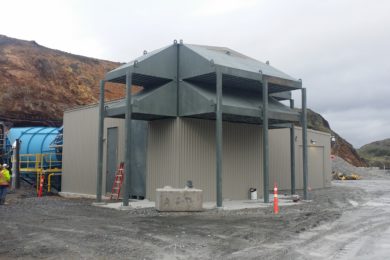Peter Terkovics, Howden Sales Director – Mining recently outlined some key trends in an interview with IM for underground mine heating systems with a focus on zero emissions electric options. In terms of what is considered to be the “greenest” option for underground mine heating from a Scope 1 emissions perspective, Terkovics commented: “Indirect is typically used where there is no access to propane or natural gas. The usual option would be diesel but of course it doesn’t burn as clean as gas. It is indirect as it heats a heat exchanger, with the warm air then taken underground. But the diesel emissions are expelled into the environment. So that would be the least ‘clean.'”
He added that the next option would be natural gas or propane – where there are emissions sent underground as the system is direct fired, and are covered by air standards regulations, though NO2 and NOX restrictions are becoming much tighter, which has led to Howden developing low NO2 heaters in the form of Ultra Low Emission Heaters cold flame technology. “But the cleanest of all in emissions terms and having the lowest carbon footprint are electric heaters, assuming of course the power has come from a green source. These can be electric only or form part of a hybrid solution with a propane/natural gas system – we installed a system like this at the Brucejack gold mine for example. Electric heating is of course limited by what power sources are available at the mine location and the power costs. Many remote mines generate their own power – but often using diesel generators so are creating emissions that way.”
He said a lot of the mines in Canada looking at electric heating are in Western Canada or Quebec where there is access to lower cost hydropower. On electric heating options – it is basically the same overall design but we do select appropriate coils to facilitate ease of maintenance, plus maximising efficiency and heat transfer. The systems are staged so that banks of elements can be brought on as needed.
Despite the fact that heating systems of any kind are a relatively small emissions contributor compared with other mine sources, notably diesel mobile fleets, Terkovics added that Howden has definitely seen an increase in enquiries for electric heating options. “But the main mine priorities currently on the Scope 1 front is looking at battery electric equipment underground. Plus in doing that the ventilation air volume requirements will be reduced, so by default you are then having to heat less air. After electrification of the mine and the mobile fleet, then the next priority will be to optimise the heating solution that is there.”
He also said that some natural thermal heat recovery is possible in a few mines – leveraging waste heat from geothermal sources underground to heat water which can be pumped and heat some of the mine that way. In very deep mines that are hot due to the thermal gradient – “you can pump some of that exhaust air up to a heat exchanger to partially heat the shaft and upper levels. The issue with that is that it is not very hot air and is also dirty and wet so it can’t be relied on to cover the mine needs. The other issue is that the supply and return air sources should be in close proximity to each other to be worthwhile. Other heat recovery options include the utilization of waste heat form other equipment such as generators, compressors, boilers, etc.” On electric heating options – it is basically the same overall design but we do select appropriate coils to facilitate ease of maintenance, plus maximising efficiency and heat transfer. The systems are staged so that banks of elements can be brought on as needed.










